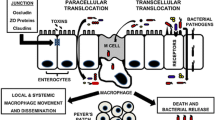Abstract
In this study we determined the risk factors for infection and colonization byCandida spp. in our Neonatal Intensive Care Unit (NICU). We designed a cohort study in the NICU of the La Paz Universitary Hospital. Over a one year period, 153 neonates admitted to the NICU were studied. In the bivariable analysis, hospitalization period, central catheterization, parenteral feeding, parenteral lipid feeding, respiratory support and premature rupture of the membranes (PRM) were statistically associated with infection and colonization; age was only associated with infection. Logistic regression was used to control the confusing factors. The hospitalization period was a risk factor for infection and colonization. PRMs were also colonization risk factors. We developed a statistical equation that predicts the probability of infection or colonization byCandida spp. that are related to a neonate's specific characteristics. The equation helps us to develop preventive procedures.
Similar content being viewed by others
References
Townsed T, Randwenzel RP. Nosocomial bloodstream infections in a newborn intensive care unit. Am J Epidemiol 1981; 114: 73–80.
Erikson M. Neonatal septicemia. Acta Pediatr Scand 1983; 72: 1–8.
Marples RR, Richardson JF, Seal DV, Coke GM. Adhesive tapes in the special care baby unit. Hosp Infect 1985; 6: 398–405.
Nelson JD. The Neonate. In: Donowitz LG (ed), Hospital acquired infection in the pediatric patient. Baltimore: Willians and Wilkins, 1988: 273–294.
Baley JE, Kliegman RM, Boxerbaum B, Fanareff AA. Fungal colonization in the very low birth weight infant. Pediatrics 1986; 78: 225–232.
La Gamma EF, Drusin LM, Mackles AW, Machalik S, Buld PA. Neonatal infections. An important determinant of late NICU mortality in infants less than 1000 g at birth. Am J Dis Child 1983; 137: 838–841.
Ashcract KW, Leape LL.Candida sepsis complicating parenteral feeding. JAMA 1970; 212: 454–456.
Maki DG. Infection due to infusion therapy. In: Bennett JV, Brachman PS (eds), Hospital infection, 3rd ed. Boston: Little Brown, 1992: 849–898.
Solomon SL, Alexander H, Eley JW, Anderson RL, Goodpasture RC, Smart S, Furman RM, Martone WJ. Nosocomial fungemia in neonates associated with intravascular pressure-monitoring devices. Pediatr Infect Dis 1986; 5: 680–685.
Van Saene HKF, Stoutenbeek CP. Prevention of infection in intensive care. Infection 1990; 18 (Suppl): s-l–s-30.
Washington JA. Classification of microorganisms on the intrinsic pathogenicity: Infection control by selective decontamination. In: Van Seane HKF, Stoutenbeek CP, Lawin P, Ledingham I (eds), Update in intensive care and emergency medicine. Berlin: Springer Verlag, 1989: 8–12.
Hoogkamp-Korstanje JAA, Cats B, Senders RCH, Van Ertbruggen I. Analysis of bacterial infections in a neonatal intensive care unit. J Hospital Infec 1982; 3: 275–284.
Whyte RK, Hussain ZD, Debea D. Antenatal infections withCandida species. R Dis Childhood 1982; 57: 528–535.
Silva-Hutner ME, Cooper BH. Yeasts of clinical importance. In: Lennette EM (ed), Manual of clinical microbiology. Washington, DC: Am Soc Microbiol, 1980.
Hosmer DWJ, Lemeshow S. Applied logistic regression. New York: John Wiley and Sons, 1989.
Hageman JR, Stensike J, Keuler H, Randall E.Candida colonization and infection in very low birth-weight (VLBW) in the intensive care nursery (ICN). Abstract. Pediatric Res 1985; 1407A.
Rothman KJ. Epidemiologia moderna. Madrid: Diaz de Santos, 1987.
Goldmann DA, Le Clair J, Mancone A. Bacterial colonization of neonates admitted to an intensive care environment. J Pediatric 1978; 93: 288–293.
Author information
Authors and Affiliations
Rights and permissions
About this article
Cite this article
Herruzo-Cabrera, R., De-Lope, C., Fernández-Arjona, M. et al. Risk factors of infection and digestive tract colonization byCandida spp. in a neonatal intensive care unit. Eur J Epidemiol 11, 291–295 (1995). https://doi.org/10.1007/BF01719433
Accepted:
Issue Date:
DOI: https://doi.org/10.1007/BF01719433




